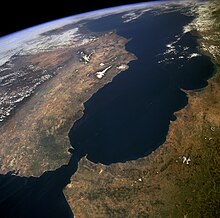Strait
| Marine habitats |
|---|
 |
| Coastal habitats |
| Ocean surface |
| Open ocean |
| Sea floor |
A strait is a naturally formed, narrow, typically navigable waterway that connects two larger, navigable bodies of water. It most commonly refers to a channel of water that lies between two land masses, but it may also refer to a navigable channel through a body of water that is otherwise not navigable, for example because it is too shallow, or because it contains an unnavigable reef or archipelago.
Terminology
The terms channel, firth, pass or passage can be synonymous and used interchangeably with strait, although each is sometimes differentiated with varying senses. Many straits are economically important. Straits can be important shipping routes, and wars have been fought for control of these straits.
Numerous artificial channels, called canals, have been constructed to connect two bodies of water over land, such as the Suez Canal. Although rivers and canals often provide passage between two large lakes or a lake and a sea, and these seem to suit the formal definition of straits, they are not usually referred to as such. The term strait is typically reserved for much larger, wider features of the marine environment. There are exceptions, with straits being called canals, Pearse Canal, for example.
Comparisons
Straits are the converse of isthmuses. That is, while straits lie between two land masses and connect two larger bodies of water, isthmuses lie between two bodies of water and connect two larger land masses.
Some straits have the potential to generate significant tidal power using tidal stream turbines. Tides are more predictable than wave power or wind power. The Pentland Firth (actually a strait) may be capable of generating 10 GW.[1] Cook Strait in New Zealand may be capable of generating 5.6GW[2] even though the total energy available in the flow is 15GW[3]
Navigational (legal) regime
Straits used for international navigation through the territorial sea between one part of the high seas or an exclusive economic zone and another part of the high seas or an exclusive economic zone are subject to the legal regime of transit passage (Strait of Gibraltar, Dover Strait, Strait of Hormuz). The regime of innocent passage applies in straits used for international navigation (1) that connect a part of high seas or an exclusive economic zone with the territorial sea of coastal nation (Strait of Tiran, Strait of Juan de Fuca, Strait of Baltiysk) and (2) in straits formed by an island of a state bordering the strait and its mainland if there exists seaward of the island a route through the high seas or through an exclusive economic zone of similar convenience with respect to navigational and hydrographical characteristics (Strait of Messina, Pentland Firth). There may be no suspension of innocent passage through such straits.
Well-known straits

Well-known straits in the world include:[citation needed]
- Bab el Mandeb, connecting the Red Sea and the Gulf of Aden.
- Bass Strait, which lies between mainland Australia and Tasmania, and depending on definition, either connects the Indian Ocean with the Pacific Ocean, or connects the Southern Ocean to the Pacific Ocean.
- Bering Strait (85 km), between Alaska and Siberia, which connects the Pacific and Arctic Oceans.
- Bosphorus and the Dardanelles, which connect the Aegean Sea and the Black Sea, with the Sea of Marmara in between.
- Cook Strait, separating the North and South Islands of New Zealand.
- Strait of Dover (34 km), between England and France, which connects the North Sea with the English Channel.
- Detroit River, connecting Lake St. Clair to Lake Erie, having lent the French translation of strait for naming the city of Detroit.
- The East River in New York City.
- Straits of Florida separate the Florida peninsula from Cuba. The Gulf Stream current originates there.
- Strait of Georgia, between Vancouver Island and mainland British Columbia.
- Strait of Gibraltar (14.3 km), the only natural passage between the Atlantic Ocean and the Mediterranean Sea.
- Strait of Hormuz connecting the Persian Gulf and the Gulf of Oman, through which Persian Gulf petroleum is shipped to the world.
- Straits of Mackinac, connecting Lake Michigan and Lake Huron.
- Strait of Magellan, connecting the Atlantic and Pacific Oceans north of Tierra del Fuego and south of mainland South America.
- Strait of Malacca, between Peninsular Malaysia and Sumatra, connecting the Indian Ocean with the South China Sea and thus the Pacific Ocean, is one of the highest-volume shipping lanes & the world's longest strait at about 500 miles.
- Menai Strait, running between the north Wales coast and the coast of Anglesey
- Strait of Messina (3.1 km), running between Calabria and Sicily.
- Palk strait, between Tamil Nadu state in India and Sri Lanka, the location of Ram Sethu and rich in natural resources.
- Pentland Firth is more a strait than a firth. It separates the Orkney Islands from Caithness in the north of Scotland.
- San Juanico Strait, narrowest strait in the Philippines, running between the islands of Samar and Leyte.
- Skagerrak, Kattegat, and the Danish straits which together connect the North Sea to the Baltic Sea.
- Taiwan Strait (180 km - 111.85 miles), between Taiwan and Mainland China.
References
This article needs additional citations for verification. (June 2010) |
- ^ "Marine Briefing" (December 2006) Scottish Renewables Forum. Glasgow.
- ^ "The Energetics of Large Tidal Turbine Arrays, Ross Vennell, 2012, preprint submitted to Royal Society, 2011."
- ^ "Estimating the power potential of tidal currents and the impact of power extraction on flow speeds. Ross Vennell, 2011" [1]
under water H


